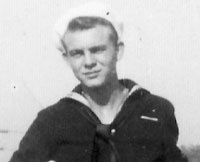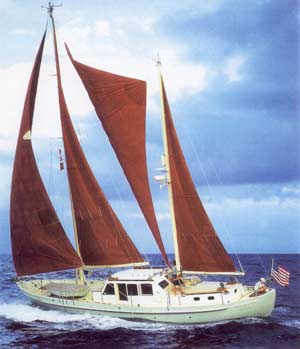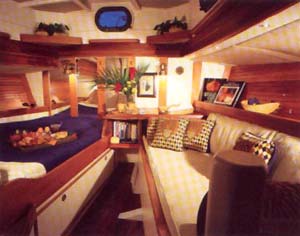 |
History:
Prewar -
1941 -
1942 -
1943 -
1944 -
1945 -
Postwar
The Ship -
All Hands -
Decorations -
Remembrance
| |
About the Author | |
| Robert J. Colson is a US Navy veteran of World War II. He served in Enterprise CV-6 from February 1941 to November 1942. His duties aboard ship put him in close contact with Admiral William F. Halsey. Each day as helmsman he steered Enterprise, except when "Man your battle stations" sounded, when he would assume his position as fuse-setter on the forward starboard 5-inch anti-aircraft gun. In port, Colson was port-side sternhook on the Admiral's barge. | |
| His battle record with Enterprise included the Gilbert and Marshall Islands raid, the Wake and Marcus Island raids, the Doolittle Tokyo raid, the Battle of Midway, the Guadalcanal landings, the Battle of the Eastern Solomons, Santa Cruz, and the Naval Battle of Guadalcanal. | |
| Colson was injured in line of duty and transferred to Noumea, New Caledonia for ambulatory treatment of wounds. He was honorably discharged on 8 March 1943. |
In early 1940, Mr. Berridge Spencer, a wealthy industrialist in New Zealand, who with his brother Ashton owned the Tasman Paper Mills and the Caxton Paper Works, ordered an Auckland shipbuilder to draw up a blueprint for a 55-foot wooden hull motor sailboat. By April 1940 an original set of plans were drawn up by the famous designer and shipbuilder, Colin Wild of the Colin Wild Yard in Stanley Bay, on Auckland's North Shore. Wild's drawing, dated April 1940, carries his name and the following notation:
Manawanui Motor Sailer. 55' L.O.A. 49.8' W.L. 13'6" beam 5'6" draft.
The name Manawanui is one word when used by the New Zealanders but two words (Manawa Nui) in the United States. In Maori, the native language of New Zealand, the name Manawanui means Great Power or Great Fortitude.
Early in 1941 Berridge Spencer placed the order with Colin Wild to start building Manawanui. Spencer's son, John B. Spencer, says "The Manawanui was built for my father and was nearing completion at the outbreak/entry of the USA into WWII. The Manawanui was confiscated by the New Zealand Government and donated to the US Navy. The vessel was sent to the South Pacific and used as an entertainment vessel for officers, although the original purpose was to assist in picking up moorings for battleships...."[1] Another source states Manawanui was officially classified as general-purpose communication vessel - unofficially still a recreation vessel for senior officers.
At the time she was seized in early 1942, Manawanui was finished to hull and decks only and had not been commissioned. The New Zealand Government arranged for her to be transferred to the US Navy under the Lend-Lease Agreement. The Lend-Lease Act was something new. Through the personal efforts and sponsorship of President Franklin Roosevelt, the Lend-Lease Act became law on 11 March 1941. It covered the sale, transfer, exchange, lease or loan of war items with chosen nations to help the USA in its wartime endeavors.
Once Manawanui was refitted for defense purposes, it was necessary to find a qualified and responsible crew for her. Army Headquarters, Noumea, interviewed a young enlisted man by the name of Heath Crow, and he was selected to be the crewmember in charge. He would tend the helm.[2] Crow had a sailing background and had enlisted in the Navy, but a military foul-up placed him in the Army instead. All the while he kept bucking for boat-work, but not until he reached New Caledonia were his efforts realized.
One of the best kept secrets of the war was the activities of a small group of rugged and fearless Australian volunteers known as the Solomon Island Coastwatchers. Developed by the Royal Australian Navy prior to World War II, the group's mission was to establish a network of 'observers' in the islands to watch the coastline in case of war and act as a kind of 'fence' around Australia.
May 1942 found Manawanui operating in and around the Solomon Islands. She was being used to ferry Australian Coastwatchers around the islands. Her shallow draft of 5 foot 6 inches allowed her to pull nearer to the islands than the larger vessels. The Japanese Navy apparently observed her as an ordinary pleasure craft engaged in fishing and sailing excursions.
A Coastwatcher was overheard to say that being put ashore to relieve others was a very dangerous experience. One had no way of knowing if the Japanese had located and killed the Coastwatcher on duty and were lying in wait to ambush the incoming relief and the vessel delivering them.
When the Pacific War began in 1941, Australian Navy Lt Commander Eric Feld, who was in charge of the Solomon Island Coastwatchers, had over 100 stations hidden on islands that stretched in a 2,500-mile crescent from the New Hebrides to Western New Guinea. Each Coastwatcher was issued a 3BZ transmitter/receiver radio made by an Australian company, Amalgamated Wireless, between 1941-45. The radio measured l6 inches wide, l0 inches high, l0 inches deep. The overall weight was 200lb. Its broadcast range under normal conditions was 400 miles. Most all of the Coastwatchers had these radios.
 A recent photo of the yacht Manawa Nui at sea. |
All through the war this brave handful of Coastwatchers hid themselves in the jungle on islands overrun with Japanese and relayed valuable radio messages about enemy troops, Japanese ship movements and aircraft operations. It was a great help for commanders on Guadalcanal to hear a radio voice say "40 bombers heading your way" two hours before they were due. It gave them time to scramble fighters and be ready when the bombers arrived.
Another great contribution they made was in rescuing our pilots who were shot down, bailed out and landed in the jungle on various Japanese-held islands. It is estimated that they saved more than 100 pilots who would otherwise have probably become, at best, Japanese POWs.
In addition they saved hundreds of survivors of ships and boats destroyed by the Japanese, including the crew of Lieutenant John F. Kennedy's PT-109.
Manawanui was now performing one of the more important secret operations that could be assigned to a yacht with her capabilities. She was originally designed and built for recreational sailing in blue water. However, she was so well designed and constructed by Colin Wild that when she assumed her wartime duties she did so with all ease. Her shallow draft, high-powered English Diesel engine, two-masted sails, and her triple-planked wooden hull, which enabled her to slip through mine fields, were all attributes that contributed greatly in her successful role as a naval vessel often assigned to clandestine activities. To illustrate her ability to maneuver through minefields, Skipper Heath Crow stated that when he was gone for one day (hospitalized due to blood poisoning in his foot), Manawanui had trouble - in a minefield. The crewmember temporarily in charge had dropped anchor (unknowingly) between four mines. Instead of letting the anchor line go, the crew tried to pull it up and nearly blew the boat out of the water.
Manawanui had been engaged in ferrying the Aussie Coastwatchers for some five months when Admiral Nimitz announced, on 18 October 1942, that he was appointing Vice Admiral William 'Bull' Halsey as Commander South Pacific Area and South Pacific Force. (Halsey relieved Vice Admiral Robert L. Ghormley and was promoted to full Admiral shortly thereafter.) Halsey immediately assumed command at South Pacific Headquarters in Noumea, New Caledonia. The capital of the French colony, Noumea was a sleepy backwater until Halsey made it his headquarters for his Pacific campaigns.
When the war started to go in our favor and the US was able to use PT boats and submarines (as they increased in numbers) for most of their clandestine activities, Manawanui was retasked by Admiral Halsey's officers for the Admiral's use. Admiral Halsey also had the use of his Admiral's Barge, with a fulltime crew to deliver him to his destinations around the harbor and nearby coastal sites.
Admiral Halsey was highly impressed and appreciative of the intelligence activities of the Australian Coastwatchers and, speaking from his South Pacific Headquarters, he praised their accomplishments, their bravery and proficiency. In a message relayed to this unique body of men he said "The intelligence information received from the Coastwatchers at Bougainville saved Guadalcanal, and Guadalcanal saved the South Pacific." Manawanui had helped make all this possible.
Admiral Halsey learnt that the First Lady, Eleanor Roosevelt, was scheduled to arrive in Noumea soon as part of a personal goodwill visit to US combat troops in the South Pacific. As her visit entailed being in several different combat zones, he and his staff were highly concerned about her safety and just how they would be able to accommodate the woman codenamed "Rover". His staff officers made immediate arrangements to prepare Manawanui for the arrival of the wife of their President and Commander-in-Chief. Manawanui would need a lot finishing and minor repair in order to be presentable to such a worthy and important guest. Everything dovetailed together.
Manawanui was tied up near Kukum Airfield (now Honiara) on Guadalcanal, which was not far from a sawmill. This Seebee Sawmill had been set up by the US Marines earlier in 1942 but had been taken over by the Royal New Zealand Air Force, after being deployed to the Solomon Islands that year. It was now referred to as the Cactus Sawmill because "Cactus" was the code name for Henderson Field, the hard-won US airfield on Guadalcanal.
Corporal Gordon A. E. Campbell RNZAF was the Saw Doctor in charge of the sawmill. The Kiwi sawmillers and carpenters were asked to dress up the inside of the boat. Corporal Campbell's widow, Muriel, remembers that the panic to prepare Manawanui in time for Eleanor's visit "nearly bloody killed him". Pressure to finish the boat came at the same time as making floors for tents for the Kiwi aircrews operating from No. 2 Fighter Strip (Kukum Field). Apparently, the Kiwis were driving him up the wall on one side and Halsey's officers on the other side. As the Saw Doctor in charge of the sawmill, Corporal Campbell selected, cut and dressed all the native mahogany timber used in Manawanui. The native mahogany trees were harvested from around the airfield perimeter and were liberally peppered with shrapnel from US and Japanese guns. The noise that the big 30-inch saw blades made when they hit a piece of shrapnel was positively horrific, and kept the saw doctors working day and night keeping a supply of sharp blades for the saws.[3]
The expedited work orders accomplished their purpose and Manawanui was now ready to receive Eleanor. Eleanor's visit started with her arrival at Christmas Island on 19 August 1943. She went on to Noumea on 26 August 1943, where she was a guest of Admiral Halsey. "When I reached Noumea [she stated] and met Admiral Halsey, I presented my letters from my husband.... Back at Noumea [14 Sept], I still did not know whether I was to be allowed to go to Guadalcanal or was starting homeward. The last evening, after I had spent the day doing all the things that had been arranged for me by Admiral Halsey, he announced that I was to be ready to leave the next morning at eight o'clock for Efate."
Regarding her trip to Efate on 16 September, Admiral Halsey admonished her not to mention the name of the island because the Japanese had never bombed it and the US had some of its biggest hospitals there. He hoped that they did not know we were established there. After her visits to Tongareva Island, Society Islands, Aitutaki, Samoa, New Zealand, Australia, Guadalcanal, Efate and Espiritu Santo, she was back on Christmas Island 19 September 1943, preparing for her journey home.
 A view of the interior of Manawa Nui's luxuriously appointed cabin. |
The men loved her and her concern for the wounded. Admiral Halsey had initially opposed her visit but changed his mind. "I marvelled at her hardihood, both physical and mental," he reported. "She saw patients who were grievously wounded. I marvelled most at their expressions as she leaned over them. It was a sight I will never forget. She alone accomplished more good than any other person who passed through my area."
"The suffering of the men," Eleanor said, "left a mark from which I think I shall never be free." During her five-week goodwill tour of the South Pacific, Eleanor spoke to approximately 400,000 men. Her journey to visit the troops had been an enormous success and now she was going home. Admiral Halsey selected Admiral Harry E. Sears, who was then assigned in the Solomon Islands, to fly Eleanor Roosevelt on the last leg of her flight to and from the South Pacific combat zone. At other times during his career, Admiral Sears was a personal pilot for James V. Forrestal, the first Secretary of Defense, Admiral Harold Stark, the wartime commander of the Pacific fleet, and Admiral Ernest J. King, the wartime Chief of Naval Operations.
Regarding Manawanui's visit to the troops, Skipper Heath Crow stated that his two most famous passengers were Admiral Halsey and Eleanor.
Manawanui had a lot of miles under her keel now and Crow had to replace the engine rather than repair it, due to lack of supplies and parts. He replaced her old original English engine with a newer Cummins American engine. The new engine weighed 2,000lbs less than the old engine. Crow made up the weight in ballast. One of New Caledonia's exports is nickel ore, which is cast in bars. Crow used these convenient size bars and filled up the bilges of Manawanui with $3,500 worth of nickel ore, which put her back in shape for duty.
After Eleanor's visit, Manawanui returned to routine assignments. When not being used by Admiral Halsey, she was assigned to carry secret agents and senior officers to their stations throughout the South Pacific, and at other times she performed anti-submarine patrols. Skipper Heath stated that on extended trips a cook was assigned to Manawanui.
Manawanui more than lived up to her name. During her wartime experiences, she went through two typhoons, one in Noumea in 1944 with 200 mile-an-hour winds that ripped through her rigging. Heath Crow, her skipper, stated that "huge swells playing catch with your hull would be hard for any yachtsman to forget." At war's end, however, she was declared "surplus to requirements".
In 1945 or early in 1946 (we have two reports), she was returned to Berridge Spencer, her original owner. He overhauled her. In the meantime he commissioned Colin Wild to build an even bigger boat, the ketch Windhaven. In 1947, John McCormick went to work at Colin Wild Shipyard at the age of 20 years. He was given an apprentice (Des Hamill) and was told to build Windhaven. This project took two years. While building her, Col (Colin Wild liked to be called Col) had two longer masts built for Manawanui. McCormick says he had to "scarf" around 10ft onto both of them. With Col's ingenuity, the gooseneck clamped around the scarves.
Mr. Spencer sailed Manawanui around Auckland until 1948, at which time he sold her to Jack C. Paine of Paine Motors in Otahuhu: a small rural town, in South Auckland. Her Auckland registration number at that time was D-7 ("D" being the registration letter for two-masted yachts). Jack Paine had her slipped at the Percy Voss Yard for a brief refit.
Later Jack Paine sold Manawanui to a local gentleman by the name of Roland Hodges. In listing the successive owners, every effort has been made to be as accurate and complete as possible. The following names are to the best of our knowledge. Roland Hodges sold to Ray Klein, who in turn, sold to Mr Toogood who took Manawanui through the Panama Canal in 1958. Toogood later sold to Juanita Chalker. Chalker sold to Peter Ullstrom, who owned her for 13 years and was responsible for the major rebuild, which saved her. Finally, Manawanui met her present owners, Robert "Skip" and Caroline Richheimer, in Ft. Lauderdale in May 1996. After a full restoration and refitting in Wickford, Rhode Island, she now claims Monterey as her home port and is run as a charter business.
Her current statistics are:
| Length Overall - | 55 feet |
| Length on Waterline - | 50 feet |
| Beam - | 13 feet 6 inches |
| Draft - | 5ft 6in |
| Displacement - | 60,000 lbs. |
| Sail area - | 1,200 square feet |
| Engine - | 250-hp. Cummins diesel |
| Fuel Capacity - | 400 gallons |
| Cruising Speed - | 8.5 knots |
| Cruising Range Under Power - | 1500 miles |
| Water Capacity - | 400 gallons plus watermaker |
Manawanui even has her own email address - Manawanui@hotmail.com.
[1] In a letter dated November 1997. Peter Spencer, Berridge Spencer's other son, resides in Panmure, New Zealand.
[2] Manawanui's wheel was a traditional one with spokes about 24 inches in diameter, cast of bronze (not wood). It was mounted on the bulkhead at the forward end of the cockpit.
[3] Squadron Leader LT Lindsay Campbell of the Royal Australian Air Force provided this information regarding his father Gordon Campbell.
Image Library -
Action Reports and Logs -
News Stories
Message Boards -
Bookstore -
Enterprise CV-6 Association
Copyright © 1998-2005 Joel Shepherd ([email protected])
Sources and Credits